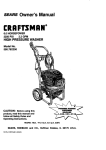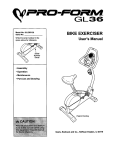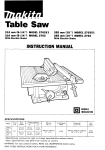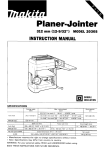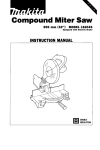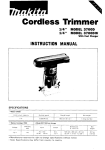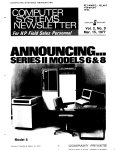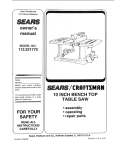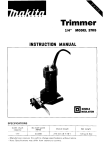Download Makita ARBOR 2711 Instruction manual
Transcript
Table Saw 255 mm (10") MODEL 2711 With Electric Brake INSTRUCTION MANUAL SPEC IFI CAT I 0NS Arbor thole Blade dldnlPtel 255 m n , iio"i Table size IL x WI Cutt,ng C a P d C m e F 90" 91 m m 13 9 16'1 45" 63 nirn 'I 12 1 z Fixed table 600 m m x 405 inmi x 15 15 16 I 1 2 3 5 8' No load 295 mm x 497 mm 111 5 8 ' x 19 $ ) I 6 I Dimensions IL Sliding table 3 800 R k " 1 0 9 0 m m x 715 m m x 4 7 0 mm 142 7 < a x 2 8 im" i a i:z' I Manufacturer reserves the right to change specifications without notice. * Note. Specifications may differ from country to country. x W x HI Ne, wetghf 32 5 kg 1716 ibsi For Your Own Safety Read Instruction Manual Before Operating Table Saw GENERAL SAFETY PRECAUTIONS (For All Tools) 1 KNOW YOUR POWER TOOL. Read the owner's manual carefully. Learn the tools applications and limitations, as well as the specific potential hazards peculiar t o it. 2. KEEP GUARDS IN PLACE and in working order. 3. REMOVE ADJUSTING KEYS AND WRENCHES. Form habit of checking t o see that keys and adjusting wrenches are removed from tool before turning it on. 4. KEEP WORK AREA CLEAN. Cluttered areas and benches invite accidents. 5. DON'T USE IN DANGEROUS ENVIRONMENT. Don't use power tools in damp or wet locations, or expose t h e m t o rain. Keep work area well lighted. 6 . KEEP CHILDREN AWAY. All visitors should be kept safe distance from work area. 7. MAKE WORKSHOP KID PROOF w i t h padlocks, master switches, or by removing starter keys. 8. DON'T FORCE TOOL. It will do the job better and safer at the rate for which it was designed. 9. USE RIGHT TOOL. Don't force tool or attachment t o do a job for which it was not designed. 10. WEAR PROPER APPAREL. Wear no loose clothing, gloves, neckties, rings. bracelets, or other jewelry which may get caught i n moving parts. Nonslip footwear is recommended. Wear protective hair covering t o contain long hair. 11. ALWAYS USE SAFETY GLASSES. Also use face or dust mask if cutting operation is dusty. Everyday eyeglasses only have impact resistant lenses, they are NOT safety glasses. 12. SECURE WORK. Use clamps or a vise t o hold work when practical. It's safer than using your hand and it frees both hands t o operate tool. 13. DON'T OVERREACH. Keep proper footing and balance at all times. 14. MAINTAIN TOOLS WITH CARE. Keep tools sharp and clean for best and safest performance. Follow instructions for lubricating and changing accessories. 15. DISCONNECT TOOLS before servicing; when changing accessories such as blades, bits, cutters, and the like. 16. REDUCE THE RISK OF UNINTENTIONAL STARTING. Make sure switch is i n off position before plugging in. 2 17. USE RECOMMENDED ACCESSORIES. Consult the owner’s manual for recommended accessories. The use of improper accessories may cause risk of injury t o persons. 18. NEVER STAND ON TOOL. Serious injury could occur if the tool is tipped or if the cutting tool is accidentally contacted. 19. CHECK DAMAGED PARTS. Before further use of the tool, a guard or other part that is damaged should be carefully checked t o determine that it will operate properly and perform its intended function - check for alignment of moving parts, binding of moving parts, breakage of parts, mounting, and any other conditions that may affect its operation. A guard or other part that is damaged should be properly repaired or replaced. 20. DIRECTION OF FEED. Feed work into a blade or cutter against the direction of rotation of the blade or cutter only. 21. NEVER LEAVE TOOL RUNNING UNATTENDED. TURN POWER OFF. Don’t leave tool until it comes t o a complete stop. 22. PROPER GROUNDING. This tool should be grounded while in use t o protect the operator from electric shock. 23. EXTENSION CORDS: Use only three-wire extension cords which have threeprong grounding-type plugs and three-pole receptacles which accept the tool’s plug. Replace or repair damaged or worn cord immediately. VOLTAGE WARNING: Before connecting the tool t o a power source (receptacle, outlet, etc.) be sure the voltage supplied is the same as that specified on the nameplate of the tool. A power source w i t h voltage greater than that specified for the tool can result in SERIOUS INJURY t o the user - as well as damage t o the tool. If in doubt, DO NOT PLUG IN THE TOOL. Using a power source w i t h voltage less than the nameplate rating is harmful t o the motor. 3 GR 0U N D IN G INSTRUCTIONS ALL GROUNDED, CORD-CONNECTED TOOLS: In the event of a malfunction or breakdown, grounding provides a path of least resistance for electric current t o reduce the risk of electric shock. This tool is equipped w i t h an electric cord having an equipment-grounding conductor and a grounding plug. The plug must be plugged into a matching outlet that is properly installed and grounded in accordance w i t h all local codes and ordinances. Do not modify the plug provided-if it will not fit the outlet, have the proper outlet installed by a qualified electrician. Improper connection of the equipment-grounding conductor can result in a risk of electric shock. The conductor w i t h insulation having an outer surface that is green w i t h or without yellow stripes is the equipment-grounding conductor. If repair or replacement of the electric cord or plug is necessary, do not connect the equipment-grounding conductor t o a live terminal. Check w i t h a qualified electrician or serviceman if the grounding instructions are not completely understood, or if in doubt as t o whether the tool is properly grounded. This tool is intended for use on a circuit that has an outlet that looks like the one illustrated in Figure A. The tool has a grounding plug that looks like the plug illustrated in Figure A. A temporary adapter, which looks like the adapter illustrated in Figure B and C, may be used t o connect this plug t o a 2-pole receptacle as shown in Figure B if a properly grounded outlet is not available. The temporary adapter should be used only until a properly grounded outlet can be installed by a qualified electrician. The green-colored rigid ear, lug, etc. extending from the adapter must be connected t o a permanent ground such as a properly grounded outlet box. GROUNDING METHODS FIG. A FIG. B FIG. C Adaoter QI Grounding Pin 4 Cover of Grounded Outlet Box - 9' Grounding Means ADDITIONAL SAFETY RULES 1. Wear eye protection. 2. Don't use the tool in presence of flammable liquids or gases. 3. Never use the tool w i t h an abrasive cut-off wheel installed. 4. Check the blade carefully for cracks or damage before operation. Replace cracked or damaged blade immediately. 5. Clean the spindle, flanges (especially the installing surface) and hex nut before installing the blade. Poor installation may cause vibration/wobbling or slippage of the blade. 6.Use saw-blade guard and spreader for every operation for which it can be used, including all through sawing operations. Through sawing operations are those in which the blade cuts completely through the workpiece as in ripping or cross cutting. Never use the tool w i t h a faulty blade guard or secure the blade guard w i t h a rope, string, etc. Any irregular operation of the blade guard should be corrected immediately. 7. Avoid cutting nails, screws, etc. Inspect for and remove all nails, screws and other foreign matter from the workpiece before operation. 8. Remove wrenches, cut-off pieces, etc. from the table before the switch is turned on. 9. Never wear gloves during operation. IO. Keep hands out of the line of saw blade. Do not stand or permit anyone else t o stand in line w i t h the path of the saw blade. 11. Make sure the blade is n o t contacting the spreader or workpiece before the switch is turned on. 12. Before cutting an actual workpiece, let the tool run for a while. Watch for vibration or wobbling that could indicate poor installation or a poorly balanced blade. 13. Use a push stick when required. Push sticks should be used for ripping narrow workpieces t o keep your hands and fingers well away from the blade. 14. Pay particular attention t o instructions for reducing risk of KICKBACK. KICKBACK is the ejection of the workpiece from the tool back towards the operator. Avoid KICKBACKS by keeping the blade sharp, by keeping the rip fence parallel t o the blade, by keeping the spreader, antikickback fingers and blade guard in place and operating properly, by not releasing the workpiece until you have pushed it all the way past the blade, and by not ripping a workpiece that is twisted or warped or does not have a straight edge t o guide along the fence. 15. Do not perform any operation freehand. Freehand means using your hands t o support or guide the workpiece. 16.Never reach around or over saw blade. 17. Avoid abrupt, fast feeding. Feed as slowly as possible when cutting hard workpieces. Do not bend or t w i s t workpiece while feeding. If you stall or 5 jam the blade in the workpiece, turn the tool off immediately. Unplug the tool. Then clear the jam. 18. Never remove cut-off pieces near the blade or touch the blade guard while the blade is running. 19. Don't abuse cord. Never yank cord t o disconnect from receptacle. Keep cord away from heat, oil, water and sharp edges. SAVE THESE INSTRUCTIONS. 6 Movement and transport of table saw Before moving the table saw, tighten the wing bolt to secure the sliding table. When moving the table saw, hold it by the fixed table and the bars. Be sure to use two persons to lift and move it. When transporting the table saw by vehicle, secure it with a rope or other substantial means. ASSEMBLY The table saw is shipped from the factory with the ruler guides, miter gauge, saw blade, rip fence, blade guard and table insert not installed. Assemble as follows. CAUTION : Always be sure that the tool is switched off and unplugged before assembly. Installing ruler guides Sliding fable Fixed fable Install the graduated ruler guide on the front side of the fixed table and the nongraduated one on the rear side. Use the hex wrench to tighten the bolts. 7 Installing miter gauge Insert the wooden gauge into the miter gauge and tighten the two screws lightly but firmly. The wooden gauge will be used later to help you accurately make crosscuts. Place the miter gauge on the sliding table with the wooden gauge extending toward the fixed table. Insert the longer miter gauge installation screw through the hole (A) in the miter gauge and screw it into the threaded hole in the sliding table. Insert the shorter miter gauge installation screw through the hole (B) and screw it into the nut in the sliding table. Loosen the wing bolt securing the sliding table before moving the sliding table. Installing or removing saw blade Hold the outer flange with the offset wrench and loosen the hex nut clockwise with the wrench (the hex nut has left hand thread). Then remove the outer flange and flange. 8 Install the blade between the two flanges. Then install the outer flange and hex nut onto the arbor, making sure the teeth of the blade are pointing down a t the front of the table. To secure the blade in place, hold the outer flange with the offset wrench, then tighten the hex nut counterclockwise with the wrench. When tightening the hex nut, the offset wrench handle should be supported by the table as shown in the figure. BE SURE TO TIGHTEN THE HEX NUT SECURELY. CAUTION : Be sure to hold the hex nut carefully with the wrench. If your grip should slip, the wrench may come off the hex nut, and your hand could strike the sharp blade edges. 9 Installing and adjusting rip fence Loosen the lever on the rip fence and f i t the rip fence on the ruler guides. Lever Rip fence Ruler guide To check to be sure that the rip fence is parallel with the blade, secure the rip fence 2 - 3 mm (5/64"- 1/8") from the blade. Raise the blade up to maximum elevation. Mark one of the blade teeth with a crayon. Measure the distance (A) and (B) between the rip fence and blade. Take both measurements using the tooth marked with the crayon. These two measurements should be identical. I f the rip fence i s not parallel with the blade, proceed as follows: Insert a screwdriver into the hole in the rear end of the rip fence, then loosen the screw counterclockwisetwo or three turns. Loosen the two bolts on the top of the rip fence with the wrench. Adjust the rip fence until it becomes parallel with the blade, then secure it by tightening the bolts. Tighten the screw in the hole in the rear end of the rip fence clockwise two or three turns. 10 1 I Tighen the lever on the rip fence. I f the rip fence is not secure enough, leave the lever in the tightened position and tighen the screw in the hole in the rear end of the rip fence clockwise. However, do not tighten the screw excessively, or the lever will become loose. I CAUTION : Be sure to adjust the rip fence parallel with the blade, or a dangerous kickback condition may occur. Move the rip fence a bit away from the blade and secure it. Use a ruler to measure the distance (A) between the rip fence and blade. Make sure that the pointer on the ruler guide points to the correct graduation. I f the pointer does not point to the correct graduation, loosen the screw on the pointer. Then align the pointer with the correct graduation and tighten the screw. Blade 11 Installing blade guard CAUTION : Before installing the blade guard, adjust the depth of cut to i t s maximum elevation. (Note: The depth of cut is adjusted to i t s maximum elevation when the table saw i s shipped from the factory.) Temporarily tighten the bolts with the offset wrench. Check to be sure that the blade and spreader are in a straight line. I f they are not properly aligned, shift the adjusting washers from one side to another until the spreader is aligned directly behind the blade. These two clearances should be equal. h r--l washer K' Spreader / Pressure plate Blade Bolt CAUTION : I f the blade and spreader are not aligned properly, a dangerous pinching condition may result during operation. Make sure they are properly aligned. There must be a clearance of about 4 5 mm (5/32"-13/64") between the spreader and the blade teeth. Adjust the spreader accordingly and tighten the bolts securely. Attach the table insert on the table, then check to see that the blade guard works smooth. 1I Soreader - , ---- CAUTION : Be sure to tighten the screws securely after installing the table insert. 12 1I Positioning table saw Locate the table saw in a well lit and level area where you can maintain good footing and balance. It should be installed in an area that leaves enough room to easily handle the size of your workpieces. The table saw should be secured with four screws or bolts to the work bench or table saw stand (optional accessory) using the holes provided in the bottom of the table saw. When securing the table saw on the work bench, make sure that there is an opening in the top of the work bench the same size as the opening in the bottom of the table saw so the sawdust can drop through. No. 10 wood screw 40 mm I l - l / Z ’ ’ l min. length If during operation there is any tendency for the table saw to tip over, slide or move, the work bench or table saw stand should be secured to the floor. 13 Hand tool storage pocket The table saw comes with a hand tool storage pocket in the base. Keep wrenches, screwdriver, etc. in this pocket. I Adjusting depth of cut The depth of cut may be adjusted by turning the knob. Turn the knob clockwise to raise the blade or counterclockwise to lower it. The depth of cut i s indicated on the scale by the pointer (A). If the knob does not turn easily, loosen the two adjusting screws on the inside of the table saw counterclockwise. If the knob is loose enough to be turned by vibration, tighten the adjusting screws clockwise. 14 1 Bevel cutting Loosen the lock lever clockwise, then tilt the blade by swinging the knob until it reaches the desired angle ( 0 to 45 degrees). The bevel is indicated on the scale by the pointer (B). After obtaining the desired angle, tighten the lock lever counterclockwise to secure the adjustment. CAUTION : After adjusting the bevel, be sure to tighten the lock lever securely. Adjusting stopper plate Secure the lock lever a t the position where the lock lever contacts the stopper plate. Make sure the blade is a t 90 degrees or 45 degrees to the table surface. I f the bevel is not a t 90 degrees or 45 degrees, proceed as follows: :I, Use the hex wrench to loosen the bolt securing the stopper plate. Z Loosen the lock lever and adjust the blade to 90 degrees or 45 degrees, then secure the lock lever. 3 Slide the stopper plate until it contacts the lock lever, then tighten the bolt securely. @ Make sure the pointer (B) points to the 0" or 45" graduation on the bevel scale when the blade i s a t 90 degrees or 45 degrees. I f it does not point to the 0" or 45" graduati!, o loosen the screws holding the pointer (B) and align the pointer (B)with the 0" or 45 graduation. Then tighten screws. (Note: The screws holding the pointer (B) are located inside the base.) 1s Adjusting miter angle Loosen the miter gauge installation screws and adjust the miter gauge to the desired angle (0 to 45 degrees). Then tighten the miter gauge installation screws securely. CAUTION : After adjusting the miter angle, be sure to tighten the miter gauge installation screws securely. Switch action To start the tool, press the "ON" button while the key is pressed in. Press the"0FF" button to stop. When operating the key and switch buttons, it is convenient to view them through the window area in the fixed table. CAUTION : When not using the tool, remove the key and store it in a secure place. This prevents unauthorized operation. 16 Operation CAUTION : *Make sure the blade guard works smoothly and properly for making both square cuts and bevel cuts before operation. *Never withdraw the workpiece while the blade i s running. I f you must withdraw the workpiece before completing a cut, first switch the tool off while holding the workpiece firmly. Wait until the blade has come to a complete stop before withdrawing the workpiece. Failure to do so may cause dangerous kickback. Never remove cut-off pieces that may be trapped inside the blade guard while the blade is running. When moving the sliding table, do not place your fingers or hands on the reverse side of the sliding table. You may get your fingers pinched between the sliding table and bars. Work helpers Push sticks, push blocks or auxiliary fence are types of "work helpers." Use them to make safe, sure cuts without the need for the operator to contact the blade with any part of the body. Push stick A push stick can be easily made from a piece of plywood 19 mm (3/4")to 25 mm (1") thick. 130 mm 15") (HI mm 9 5 mm 3/8"1 19 mm (314"I 40 mm (1-1 12"l '1 380 mm (15"l Cut out the hatched area on the stick and smooth edges with a file. (H) dimension should be less than 12.7 mm (1/2") so as to be thinner than the workpiece. 17 Push block Use a 19 mm (3/4") piece of plywood. 120 . mm Faceledge parallel (5") (5") 6 mm (1/4"l 5o mm (2") Handle should be in center of plywood piece. Fasten with glue and wood screws as shown. Small piece 9.5 mm x 8 mm x 50 mm (3/8"x 5/16" x 2") of wood must always be glued to plywood to keep the blade from dulling if the operator cuts into push block by mistake. (Never use nails in push block.) Auxiliary fence Make auxiliary fence from 9.5 mm (3/8") and 19 mm (3/4")plywood pieces. 1 9 mm (314'') 9.5 mm Faceledge parallel (18") 4 0 mm (1 -1 12" I (5-112") Fasten with glue and wood screws. Wood facing (Rip fence) A wood facing should be used for operations when the blade comes close to the rip fence. Wood facing for the rip fence should be same size as the rip fence. Make sure the bottom of facing is flush with the table surface. 18 Crosscutting CAUTION : When making a crosscut, remove the rip fence from the table. When cutting long or large workpieces, always provide adequate support to the sides of the table. The support should be a t the same height as the table. (1; Loosen the wing bolt securing the sliding table. 0)Adjust the blade to 90 degrees to the table surface. Adjust the miter gauge to 0 degree. Switch the tool on and move the sliding table forward to cut the wooden gauge. Align the cutting line on the workpiece with the end of the wooden gauge. 131 Adjust the depth of cut a bit higher than the thickness of the workpiece. Firmly hold the workpiece flush against the miter gauge and move the sliding table forward gently to cut the workpiece. Miter cutting Adjust the miter gauge to the desired angle ( 0 to 45 degrees) and tighten the miter gauge installation screws securely. Follow the same procedure as’mentioned in @ for crosscutting. 19 The wooden gauge cannot be used for miter cutting. NOTE: Miter cutting capacity is less than crosscutting capacity. Make sure of the max miter cutting capacity before operation. The following reference table indicates some examples of miter cutting capacity. Cutting capacity Miter angle Bevel angle 0" I Thickness I Width 290 mm (1 1 -3/8") n 4 l O0 19 mm (3/4") 45 * 63" 260 mm (1 0-1 /4") (2-1/2") 210 mm (8-1 /4") 19 mm (3/4") 255 mm (10") 55mm (2-1/8") 220 m m (8-5/8") 0" * 45O * 18mm (23/32") 270 mm ( 1 0-5/8") 45" 0" 45" * 91" (3-9/1 6" ) 70 mm (2-3/4") 19 mm (3/4") 60 mm (2-3/8") max. thickness at each angles. (The illustrations in the reference table show the table saw in use with the blade guard removed. This is done only in the interest of the clarity of the illustrations and should not be construed as a normal working procedure.) 20 When a spacer block can be placed between the miter gauge and workpiece, you can obtain a greater miter cutting capacity. Ripping CAUTION When ripping, remove the miter gauge from the sliding table. .When cutting long or large workpieces, always provide adequate support behind the table. The support should be a t the same height as the table. Before operating the table saw, check to be sure that the antikickback fingers operate properly. Turn the tool off and unplug it. Feed the workpiece under the blade guard and along both sides of the blade to simulate cutting. Try to withdraw the workpiece on each side by pulling it toward you. The antikickback fingers should grab the workpiece and prevent it from moving back toward the operator. Always keep the antikickback fingers sharp so they will operate properly. Keep them sharp by using round -shaped file to maintain the original shape of the fingers. @ Adjust the depth of cut a bit higher than the thickness of the workpiece. @ Tighten the wing bolt to secure the sliding table. @) Position the rip fence to the desired width of rip and lock in place by tightening the lever. Before ripping, make sure the rear end of the rip fence is secured firmly. I f it i s not secured enough, follow the procedure in "Adjusting rip fence". (P.11) a Turn the tool on and gently feed the workpiece into the blade along with the rip fence. 21 i) When the width of rip i s 150 mm (6") and wider, carefully use your right hand to feed the workpiece. Use your left hand to hold the workpiece in position against the rip fence. ii) When the width of rip i s 65 mm 150 mm (2-1/2" - 6") wide, use the push stick to feed the workpiece. iii) When the width of rip is narrower than 65 mm (2-1/2"), the push stick cannot be used because the push stick will strike the balde guard. Use the auxiliary fence and push block. Attach the auxiliary fence to the rip fence with two "C" clamps. 22 I Feed the workpiece by hand until the end is about 25 mm ( I ” ) from the front edge of the table. Continue to feed using the push block on the top of the auxiliary fence until the cut is complete. 23 MA1NT ENANCE CAUTION : Always be sure that the tool is switched off and unplugged before attempting to perform inspection or maintenance. Cleaning Clean out sawdust and chips from time to time. Carefully clean the balde guard and moving parts inside the table saw. Lubrication To keep the table saw in tip-top running condition, and to assure maximum service life, oil or grease the moving parts and rotating parts from time to time. Use machine oil #I20 to wet the felt on the slide table and the bars. Use grease or machine oil #I20 for the moving parts under the table. Replacing carbon brushes Remove and check the carbon brushes regularly. Replace when they wear down to the timit mark. Keep the carbon brushes clean and free to slip in the holders. Both carbon brushes should be replaced a t the same time. Use only identical carbon brushes. Use a screwdriver to remove the brush holder caps. To replace the carbon brush in the side near the table, lower the blade as far as possible by turning the knob. Loosen the lock lever, tilt the blade and secure it a t 45 degrees. Then loosen the brush holder cap while viewing it through the opening in the base. Remove the worn carbon brushes, insert the new ones and secure the brush holder caps. To maintain product SAFETY and RELIABILITY, repairs, any other maintenance or adjustment should be performed by Makita Authorized or Factory Service Centers, always using Makita replacement parts. 24 ACCESSORIES CAUTION : These accessories or attachments are recommended for use with your Makita tool specified in this manual. The use of any other accessories or attachments might present a risk of injury to persons. The accessories or attachments should be used only in the proper and intended manner Dado head set (Part No 191794-9) A dado is cutting a rabbet or a wide groove into the workpiece. The dado head set consists of two outside cutters, five inside cutters and three rings. Outside cutters Inside cutters Inside cutter Rings Paper washers : 6" diameter, 1/8" thick, 5/8" arbor hole, 2 pcs. : 6" diameter, 1/8" thick, 5/8" : 6" diameter, 1/16" thick, 5/8" 518" : 5/8" arbor hole, 4 pcs. arbor hole, 1 pc. arbor hole, 3 pcs. arbor hole, 6 pcs. Various combinations of these cutters are used to cut grooves from 1/8" to 13/16" for use in making joints, tenoning, grooving, etc. To install the dado head set, proceed as follows: Turn the tool off and unplug it before installing. 1(: (2; Remove the blade guard with the spreader. 3, Install the dado head s e t with the teeth pointing down a t the front of the table 25 @ Use the chart below to select the proper cutters to obtain the various cutting widths. Flange Outslde cutter Ring ,',~~~e cutter I -*+tI I 114" I I 5116" I I I 1 0 x 2 7/16" 112" 0 9/16" I I o x 3 518" I o 11116" 0 314" 13116" 0 0 1 0 x 4 0 0 0 CAUTION : For a 1/8" cut width, the outside cutter is assembled to the spindle in the same manner as the saw blade. The outer flange must be used for each cut width. The hex nut alone must not be used to secure the dado on to the spindle. NOTE : When widths slightly greater than the above are required, fit the paper washers in between the inside and outside cutters to adjust the width. @ Arrange the cutters so that the tips of the inside cutters are positioned a t the gullets of the outside cutter. When more than one inside cutter i s used, space the tips of the inside cutters equidistantly in relation to one another. Poorly spaced cutters may cause vibration and noise. 26 When installing two outside cutters without any inside cutter, be sure that the cutter tips do not face each other. 0 X @ While tightening the hex nut, be careful to maintain the even spacing between the tips of the inside cutters. @ When cutting 1/2" or narrower grooves, use the table insert originally installed on the table saw. When cutting 9/16" or wider, use optional accessory table insert (Part No. 343396-9). Be sure to install proper table insert. @ Rotate the dado head one turn by hand to make sure that it does not contact anything before operation. When dadoing, use featherboards. The diagram shown illustrates dimensions for making a typical featherbord. It should be made from a straight piece of wood that i s free of knots or craks. Kerf should be 27 Featherbords are used to keep the workpiece in contact with the rip fence and table as shown, and to stop kickbacks. To install featherbords. proceed as follows : @ Turn the tool off and unplug it. @ Add 8" high flat facing board to the rip fence, the full length of the rip fence. @ Mount featherboards to the rip fence and table as shown, so that the leading edges of featherboard will support the workpiece until the cut is complete, and the workpiece has been pushed completely past the cutter with a push stick. @ Make sure featherboards are securely attached. When using the miter gauge during dodoing, featherboards should not be employed. Place a spacer block between the miter gauge and workpiece so that the workpiece can be pushed completely past the cutter. When the miter agnle is 0 degree, the spacer block should be about 3" wide. CAUTION : *Only the Makita dodo head set (Part No. 191794-9) should be used with Makita table saw Model 271 1. *After dadoing, always replace the blade guard with the spreader back in i t s original position on the table saw. Refer to alignment instructions on page 12. Never attempt bevel cuts when dadoing. Never dado if there is vibration (flutter) or a strange noise. Never attempt dados in other than wood. *When using a dado head set, the depth of cut is not indicated by the pointer (A). (See the depth adjustment section.) To know the depth of cut, you must measure it with a ruler. 28 Ring (Part No. 257137-6) When cutting groove 1/4", 5/16", 3/8", 7/16", 1/2", 9/16" or 5/8", use this ring or rings. Table insert (Part No. 343396-9) When cutting grooves 9/16" or wider, use this table insert instead of the standard table insert. Table saw stand (Part No. STEX 122251 1 Place the stays on a level location and assemble the legs inside. Secure with the bolts and nuts, then attach the rubber caps to the ends of the legs. Now set the table saw on top of the assembled stand and secure with four bolts, washers and nuts. 29 Saw blades 0 Chisel tooth combination saw blade For rip and cross-cut work. Most frequently used for general carpentry. Hole Part No. 255-7A 0 I 255 (10") I 518'' I 36 1 792317-2 Carbide-tipped saw blade Fastest, smoothest longer sawing without blade sharpening cuts wood, drywall, plastic, hardwood, etc. Hole Part No. I 255-11F 0 Ruller guide F Part No. 331308-4 Rip fence Part No 122328-7 0 !Screwdriver 2 Part No. 783002-8 0 Offset wrench 1 3 - 2 2 Part No. 782015-6 30 I 0 Ruller guide R Part No. 331293-1 0 Switch button Part No. 41 1447-7 Hex socket head bolt (For ruller guide) Part No. 922337-4 I I 255 (10") I I 5/8" I 22 0 Hex wrench 5 Part No. 783203-8 0 Wrench 1 9 Part No. 781010-3 1792424-1 Holder set (Part No. 191773-7) Convenient to attach for better support of long workpieces. Attach the holder to the reverse side of the I I CAUTION : Never attempt to lift or move the table saw while holding the holders. When moving the table saw, hold it by the fixed table and the bars. Hood set (Part No. 191793-1) When you wish to maintan clean operations through easy dust collection, connect the vacuum cleaner (Makita Model 410) t o the table saw using this hood. 31 Jan 255 mm (IO") TABLE SAW Model 2711 32 2 2 ' 8 7 US Note. The switch and other part configurations may differ from country to country 33 Jan MODEL 2711 $FD sD DESCRIPTION DESCRIPTION MACHINE ~ 2 3 4 5 6 7 8 9 IO 11 12 13 14 15 16 17 18 19 20 21 22 23 24 26 27 28 29 30 31 32 33 34 35 36 37 38 39 40 41 42 43 44 45 46 47 48 49 50 51 52 53 54 55 56 57 58 59 60 61 62 63 64 ~ 2 1 2 2 4 1 1 1 1 1 1 1 2 1 1 1 1 1 1 1 1 1 1 1 1 7 1 2 1 4 4 1 1 1 2 1 1 1 1 1 1 1 1 1 1 1 1 1 1 2 1 1 2 1 1 1 1 1 1 1 1 2 1 - Hex Bolt M 5 r 6 5 [With Washer] Rubber Pin 4 Brush Holder Cap Carbon Brush Pan Head Screw M5x40 [With Washerl PO" Motor Housing Flat Washer 18 Ball Bearing 620oC8 Dust Seal 10 FIELD ASSEMBLY Baffle Plate Pan Head Screw M4x10 [With Warherl Terminal Box ARMATURE ASSEMBLY IWiih Item 9 1 0 & 15 181 Fan 97 Dust Seal 1 5 Ball Bearing 6202LLB Rubber Pin 6 Pan Head Screw M4x8 [With Washerl Gear Housing Cord Pan Head Screw M4x14 IWlth Washer) Strain Relief Blade Guard Adjusting Washer Pressure Plate Hex Bolt M a r 2 5 [With Washeri Woodruff Key 4 Pan Head Screw M 5 r 3 0 lWilh Washeri Hex Bolt M 6 r 1 6 lWith Warherl Retaining Ring S - 17 Needle Bearing 121 5 Tension Spring 14 Pan Head Screw M5x30 [With Washer) Retainer Compresston Spring 24 Reta,"e. Nylon Pin 10 Feed Nu1 Hex Bolt M 1 0 Flat Washer 12 Link Flat Washer 10 Hex Bolt M 1 0 x I B Set Screw M5x6 Lock Lever Knob 45 Spring Pin 5 16 Pan Head Screw M4x10 [With Washer) Screw Guide Screw Bar M 1 2 Pan Head Screw M5x8 IWgth Washer1 PO,"fe, Flat Washer 9 Spring Washer I O Hex Nut M 1 0 Flat Washer 9 Sleeve 9 Spring Pm 5 - 16 Chip Guide Pan Head Screw M5x8 IWGth Washerl Frame 65 66 67 68 69 70 71 72 74 75 76 77 78 79 80 81 82 83 84 85 86 87 88 89 90 91 92 93 94 95 96 97 98 99 100 101 102 103 104 105 106 107 108 109 I10 111 112 113 114 115 116 117 I18 119 120 121 122 123 124 125 126 127 901 1 1 1 1 1 1 1 1 1 1 1 1 1 1 1 3 2 1 1 2 1 4 4 4 4 4 2 1 2 2 1 2 4 4 2 1 1 2 2 1 1 2 2 1 2 2 1 1 1 2 4 1 4 5 2 1 2 1 2 2 2 1 2 - __ Note The SWttch and other pail specificatmns may difler trom country to country 34 Inner Race 8 1 0 =,n 8 ielical Gear 49 W a i n i n g Ring S nouslng 20 COW 3811 Bearing 6204LLB 3earing Retainer 31 48 Spindle Duter Flange 30 Hex Nu1 M 1 2 19 Screw M I 0 Screw M 1 0 'Aler Gauge Guide Utter Gauge Plate l e x Nut M 1 0 Countersunk Head Screw M5116 Pan Head Screw M5x12 Wooden Gauge Table Insert P a n Head Screw M6x16 Flxed Table Hex Socket Head Bolt M6x16 Flaf Washer 8 Hex Socket Head Bolt M a x 4 0 Hex Socket Head Boll M6x35 Flat Washer 6 Holder Bar Sliding Table Felf Slide Guide R Slide Bar Set Plate Pan Head Screw M5x25 lWilh Washerl Felt Slide Guide L Slide Bar Slide Stopper Pan Head Screw M6x16 lWith Washerl Cushion Compression Spring I Wing Bolt M5x25 Set Plate Pan Head Screw M5x16 IWith Washer] Switch Cord Guard Pan Head Screw M4x25 lWith Washer] Strain Relief Cord Guard Cord Pan Head Screw M3x35 Cap 20 Base Hex Nut M 6 Pan Head S c r e w M6x25 IWith Washer1 Stopper Plate Front Plate Pan Head Screw M6x16 lWith Washer] Name Plate Pan Head Screw M6x22 lWith Wdsherl Flat Washer 6 Hex Socket Head Boll M 6 x l O Lock Off Switch Button Flange 50 22 8 7 US MAKITA LIMITED ONE YEAR WARRANTY Warranty Policy Every Makita tool is thoroughly inspected and tested before leaving the factory. It is warranted t o be free of defects from workmanship and materials for the period of ONE YEAR from the date of original purchase. Should any trouble develop during this one-year period, return the COMPLETE tool, freight prepaid, t o one of Makita’s Factory or Authorized Service Centers. If inspection shows the trouble is caused by defective workmanship or material, Makita will repair (or at our option, replace) without charge. This Warranty does not apply where: 8 repairs have been made or attempted by others: 8 repairs are required because of normal wear and tear 8 The tool has been abused, misused or improperly maintained; 8 alterations have been made t o the tool. IN NO EVENT SHALL MAKITA BE LIABLE FOR ANY INDIRECT, INCIDENTAL OR CONSEQUENTIAL DAMAGES FROM THE SALE OR USE O F THE PRODUCT. THIS DISCLAIMER APPLIES BOTH DURING AND AFTER THE TERM OF THIS WARRANTY. MAKITA DISCLAIMS LIABILITY FOR ANY IMPLIED WARRANTIES, INCLUDING IMPLIED WARRANTIES O F “MERCHANTABILITY” AND “FITNESS FOR A SPECIFIC PURPOSE,” AFTER THE ONE-YEAR TERM O F THIS WARRANTY. Tlu, Warranty g~vesyou spe~ificlegal nghts. dnd you may also have other nghts WhiLh vdry from \talc 10 state. Some states d o not allow the exclusion or limitdtion 01 incidental or consequentidl damages, so the above limitation or exclusion may not apply to you. Some states do not allow limitation on how long an implied warranty lasts, so the above limitation may not apply to you. Makita Corporation 3-11-8, Sumiyoshi-cho, Anjo, Aichi 446 Japan 88357 1BOW PRINTED IN JAPAN 1993-4-N



































